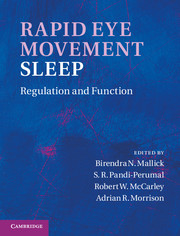Book contents
- Frontmatter
- Contents
- Contributors
- Preface
- Acknowledgments
- Organization
- Section I Historical context
- Section II General biology
- Section III Neuronal regulation
- Section IV Neuroanatomy and neurochemistry
- 19 Aminergic influences in the regulation of basic REM sleep processes
- 20 REM sleep regulation by cholinergic neurons: highlights from 1999 to 2009
- 21 GABAergic modulation of REM sleep
- 22 Glutamatergic regulation of REM sleep
- 23 The role of tuberomammillary nucleus histaminergic neurons, and of their receptors, in the regulation of sleep and waking
- 24 Hypocretinergic system: role in REM-sleep regulation
- 25 Neuropeptides and REM sleep
- 26 Adenosine and glycine in REM-sleep regulation
- 27 Changes in neurotransmitter levels in relation to REM sleep for its regulation
- 28 Pontine areas inhibiting REM sleep
- 29 Neuronal models of REM-sleep control: evolving concepts
- Section V Functional significance
- Section VI Disturbance in the REM sleep-generating mechanism
- Index
- Plate section
- References
24 - Hypocretinergic system: role in REM-sleep regulation
from Section IV - Neuroanatomy and neurochemistry
Published online by Cambridge University Press: 07 September 2011
- Frontmatter
- Contents
- Contributors
- Preface
- Acknowledgments
- Organization
- Section I Historical context
- Section II General biology
- Section III Neuronal regulation
- Section IV Neuroanatomy and neurochemistry
- 19 Aminergic influences in the regulation of basic REM sleep processes
- 20 REM sleep regulation by cholinergic neurons: highlights from 1999 to 2009
- 21 GABAergic modulation of REM sleep
- 22 Glutamatergic regulation of REM sleep
- 23 The role of tuberomammillary nucleus histaminergic neurons, and of their receptors, in the regulation of sleep and waking
- 24 Hypocretinergic system: role in REM-sleep regulation
- 25 Neuropeptides and REM sleep
- 26 Adenosine and glycine in REM-sleep regulation
- 27 Changes in neurotransmitter levels in relation to REM sleep for its regulation
- 28 Pontine areas inhibiting REM sleep
- 29 Neuronal models of REM-sleep control: evolving concepts
- Section V Functional significance
- Section VI Disturbance in the REM sleep-generating mechanism
- Index
- Plate section
- References
Summary
Summary
The hypocretins (HCRTs) are two hypothalamic peptides that have been implicated in a variety of functions including the regulation of behavioral arousal. In the brain, HCRT-expressing neurons are localized within the perifornical-lateral hypothalamic area, where they are intermingled with various other neuronal groups, including GABAergic, glutamatergic, and melanin-concentrating hormone containing neurons. Hypocretin neurons are active during behavioral arousal and are quiet during non-REM and REM sleep. Deficiency of HCRTergic signaling is linked to the symptoms of narcolepsy in humans, dogs, and rodents. Narcolepsy is a debilitating sleep disorder characterized by excessive daytime sleepiness, disrupted nighttime sleep, sleep-onset REM sleep, and sudden loss of muscle tone during waking (cataplexy). Hypocretin neurons project extensively to brain structures, especially to those that are involved in arousal and motor control as well as receive extensive inputs from areas regulating emotions, autonomic tone, appetite, circadian rhythms, and sleep–wake behavior. Therefore, HCRT neurons are well positioned to integrate a variety of interoceptive and homeostatic signals to increase behavioral arousal and suppress REM sleep and its atonia. This chapter provides a brief review of the HCRTergic system, its interactions with other neuronal systems involved in sleep–wake regulation, and the neuronal circuitry and the potential mechanism(s) by which the HCRTergic system promotes behavioral arousal and suppresses REM sleep and its muscle atonia.
- Type
- Chapter
- Information
- Rapid Eye Movement SleepRegulation and Function, pp. 234 - 246Publisher: Cambridge University PressPrint publication year: 2011



